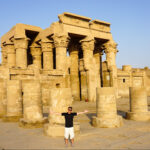The awe-inspiring “Colossi of Memnon” are two colossal stone statues situated in the Theban necropolis near Luxor, Egypt. Standing at an impressive height of approximately 18 meters (60 feet), these monumental sculptures depict Pharaoh Amenhotep III seated on his throne. These magnificent statues have stood the test of time, serving as a testament to the grandeur and artistry of ancient Egyptian civilization.
Unveiling the Mysteries: Construction and Significance
The construction of the Colossi of Memnon dates back to around 1350 BC during the reign of Pharaoh Amenhotep III of the 18th dynasty. Carved from single blocks of quartzite sandstone, each statue is a marvel of ancient engineering and craftsmanship. The figures were strategically placed at the entrance of Amenhotep III’s mortuary temple, which once stood as a majestic complex dedicated to the Pharaoh’s cult.
These imposing statues held significant religious and cultural importance. They were designed to stand guard over the entrance of the mortuary temple, symbolizing the Pharaoh’s divine authority and eternal presence. The statues were also believed to protect the deceased king’s spirit, ensuring his safe passage to the afterlife.

The Enigmatic Name: Who Was Memnon?
The name “Memnon” has sparked intrigue and speculation throughout history. In Greek mythology, Memnon was a hero and warrior who fought bravely in the Trojan War. The association of the statues with Memnon is likely due to the haunting musical sounds they emitted at dawn, which the ancient Greeks believed to be the voice of Memnon mourning for his fallen comrades.
Unearthing the Myths: The Singing Statues
The “singing” Colossi of Memnon phenomenon has intrigued visitors for centuries. At sunrise, the statues would emit eerie and musical sounds, which were attributed to the warming of the stone by the sun’s rays. These sounds were said to resemble the mournful cries of a human voice, leading to the belief that Memnon’s spirit was communicating with the gods.
However, in 27 BC, an earthquake shattered the northern statue, causing the sound-producing mechanism to cease. Emperor Septimius Severus later repaired the figure, and although it no longer “sings,” the Colossi of Memnon continues to captivate the imagination of visitors worldwide.
Rediscovery and Modern Exploration
The Colossi of Memnon have left an indelible mark on history, attracting travelers, scholars, and explorers over the centuries. In the 19th century, renowned archaeologists such as Giovanni Belzoni and Howard Carter contributed to exploring and understanding these iconic statues.
Today, visitors can admire the Colossi of Memnon as part of their journey through the ancient wonders of Egypt. The statues stand as silent witnesses to the passage of time, offering a glimpse into the artistry and reverence of a bygone era.
Exploring Nearby Attractions: A Trip Through Ancient Egypt
A visit to the Colossi of Memnon opens the door to a world of archaeological wonders. Nearby, you can explore the Valley of the Kings, a burial ground for pharaohs and nobles, and the impressive Temple of Hatshepsut, a testament to one of ancient Egypt’s most influential female rulers. Immerse yourself in the rich history and captivating stories of these remarkable sites.

FAQs about the Colossi of Memnon
What is the significance of the Colossi of Memnon?
The Colossi of Memnon held religious and cultural significance, symbolizing the authority of Pharaoh Amenhotep III and serving as protectors of his spirit in the afterlife.
Why are they called the “Colossi of Memnon”?
The statues are associated with the Greek hero Memnon due to the musical sounds they emitted at sunrise, resembling mournful cries.
Can you still hear the “singing” sounds today?
No, the sound-producing mechanism was silenced by an earthquake in 27 BC, but the statues remain a captivating historical and architectural marvel.
What other attractions can I visit near the Colossi of Memnon?
Nearby attractions include the Valley of the Kings, the Temple of Hatshepsut, and various archaeological sites that offer insights into ancient Egyptian culture.
How was the Colossi of Memnon repaired after the earthquake?
Emperor Septimius Severus repaired the shattered statue, restoring its form but ending the phenomenon of the “singing” sounds.
What is the material used in constructing the Colossi of Memnon?
The statues are carved from quartzite sandstone, showcasing the ancient Egyptians’ mastery of stone carving and monumental construction.
Conclusion
The Colossi of Memnon are enduring symbols of Egypt’s rich heritage and the remarkable achievements of its ancient civilization. These colossal statues, shrouded in myths and legends, continue to inspire awe and wonder, inviting us to contemplate the mysteries of the past. As you stand in their presence, you can’t help but feel a connection to the distant echoes of history, a testament to the enduring legacy of the “Colossi of Memnon.”




